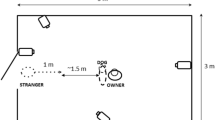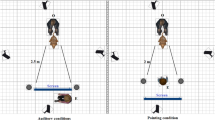Abstract
Evidence from the literature indicates that dogs’ choices can be influenced by human-delivered social cues, such as pointing, and pointing combined with facial expression, intonation (i.e., rising and falling voice pitch), and/or words. The present study used an object choice task to investigate whether intonation conveys unique information in the absence of other salient cues. We removed facial expression cues and speech information by delivering cues with the experimenter’s back to the dog and by using nonword vocalizations. During each trial, the dog was presented with pairs of the following three vocal cues: Positive (happy-sounding), Negative (sad-sounding), and Breath (neutral control). In Experiment 1, where dogs received only these vocal cue pairings, dogs preferred the Positive intonation, and there was no difference in choice behavior between Negative or Breath. In Experiment 2, we included a point cue with one of the two vocal cues in each pairing. Here, dogs preferred containers receiving pointing cues as well as Negative intonation, and preference was greatest when both of these cues were presented together. Taken together, these findings indicate that dogs can indeed extract information from vocal intonation alone, and may use intonation as a social referencing cue. However, the effect of intonation on behavior appears to be strongly influenced by the presence of pointing, which is known to be a highly salient visual cue for dogs. It is possible that in the presence of a point cue, intonation may shift from informative to instructive.




Similar content being viewed by others
Notes
In these two studies, dogs chose between containers cued with a happy display and a neutral display, which is conceptually similar to the Breath control in the current study.
References
Albuquerque N, Guo K, Wilkinson A, Savalli C, Otta E, Mills D (2016) Dogs recognize dog and human emotions. Biol Lett 12:20150883. https://doi.org/10.1098/rsbl.2015.0883
Andics A, Gácsi M, Faragó T, Kis A, Miklósi Á (2014) Voice-sensitive regions in the dog and human brain are revealed by comparative fMRI. Curr Biol 24:574–578. https://doi.org/10.1016/j.cub.2014.01.058
Andics A, Gábor A, Gácsi M, Faragó T, Szabó D, Miklósi Á (2016) Neural mechanisms for lexical processing in dogs. Science 353:1030–1032. https://doi.org/10.1126/science.aaf3777
Ben-Aderet T, Gallego-Abenza M, Reby D, Mathevon N (2017) Dog-directed speech: Why do we use it and do dogs pay attention to it? Proc R Soc B 284:20162429. https://doi.org/10.1098/rspb.2016.2429
Bjelland JA (2010) Imagine life with a well-behaved dog: a 3-step positive dog-training program. St. Martin’s Griffin, New York
Buttelmann D, Tomasello M (2013) Can domestic dogs (Canis familiaris) use referential emotional expressions to locate hidden food? Anim Cognit 16:137–145. https://doi.org/10.1007/s10071-012-0560-4
Campos JJ, Stenberg C (1981) Perception, appraisal, and emotion: the onset of social referencing. In: Lamb ME, Sherrod LR (eds) Infant social cognition: empirical and theoretical considerations. Erlbaum, New Jersey, pp 273–314
Campos JJ, Mumme DL, Kermoian R, Campos RG (1994) A functionalist perspective on the nature of emotion. Monogr Soc Res Child Dev 59:284–303. https://doi.org/10.1111/j.1540-5834.1994.tb01289.x
Carpenter M, Nagell K, Tomasello M, Butterworth G, Moore C (1998) Social cognition, joint attention, and communicative competence from 9 to 15 months of age. Monogr Soc Res Child Dev 63:1–174. https://doi.org/10.2307/1166214
Dorey NR, Udell MAR, Wynne CDL (2010) When do domestic dogs, Canis familiaris, start to understand human pointing? The role of ontogeny in the development of interspecies communication. Anim Behav 79:37–41. https://doi.org/10.1016/j.anbehav.2009.09.032
Fernald A (1985) Four-month-old infants prefer to listen to Motherese. Infant Behav Dev 8:181–195. https://doi.org/10.1016/S0163-6383(85)80005-9
Fernald A, Kuhl P (1987) Acoustic determinants of infant preference for Motherese speech. Infant Behav Dev 10:279–293. https://doi.org/10.1016/0163-6383(87)90017-8
Flom R, Gartman P (2016) Does affective information influence domestic dogs’ (Canis lupus familiaris) point-following behavior? Anim Cognit 19:317–327. https://doi.org/10.1007/s10071-015-0934-5
Hare B, Tomasello M (2005) Human-like social skills in dogs? Trends Cognit Sci 9:439–444. https://doi.org/10.1016/j.tcis.2005.07.003
Hare B, Brown M, Williamson C, Tomasello M (2002) The domestication of social cognition in dogs. Science 298:1634–1636. https://doi.org/10.1126/science.1072702
Hernádi A, Kis A, Turcsán B, Topál J (2012) Man’s underground best friend: domestic ferrets, unlike the wild forms, show evidence of dog-like social-cognitive skills. PLoS One 7:e43267. https://doi.org/10.1371/journal.pone.0043267
Heyes CM, Galef BG (1996) Social learning in animals: the roots of culture. Academic Press, California
Horowitz A (2011) Theory of mind in dogs? Examining method and concept. Learn Behav 39:314–317. https://doi.org/10.3758/s13420-011-0041-7
Huber A, Barber ALA, Faragó T, Müller CA, Huber A (2017) Investigating emotional contagion in dogs (Canis familiaris) to emotional sounds of humans and conspecifics. Anim Cognit 20:703–715. https://doi.org/10.1007/s10071-017-1092-8
Kaminski J, Nitzschner M (2013) Do dogs get the point? A review of dog-human communication ability. Learn Motiv 44:294–302. https://doi.org/10.1016/j.mot.2013.05.001
Kaminski J, Schulz L, Tomasello M (2012) How dogs know when communication is intended for them. Dev Sci 15:222–232. https://doi.org/10.1111/j.1467-7687.2011.01120.x
Kendon A (1980) Gesticulation and speech: two aspects of the process of utterance. In: Key MR (ed) The relationship of verbal and non-verbal communication. Mouton, The Hague, pp 207–227
Kirchhofer KC, Zimmermann F, Kaminski J, Tomasello M (2012) Dogs (Canis familiaris), but not chimpanzees (Pan troglodytes), understand imperative pointing. PLoS One 7:e30913. https://doi.org/10.1371/journal.pone.0030913
MacLean EL, Krupenye C, Hare B (2014) Dogs (Canis familiaris) account for body orientation but not visual barriers when responding to pointing gestures. J Comp Psychol 128:285–297. https://doi.org/10.1037/a0035742
McConnell PB (1990) Acoustic structure and receiver response in domestic dogs, Canis familiaris. Anim Behav 39:897–904. https://doi.org/10.1016/S0003-3472(05)80954-6
McKinley J, Sambrook TD (2000) Use of human-given cues by domestic dogs (Canis familiaris) and horses (Equus caballus). Anim Cognit 3:13–22. https://doi.org/10.1007/s100710050046
Merola I, Prato-Previde E, Marshall-Pescini S (2012) Social referencing in dog-owner dyads? Anim Cognit 15:175–185. https://doi.org/10.1007/s10071-011-0443-0
Merola I, Prato-Previde E, Lazzaroni M, Marshall-Pescini S (2014) Dogs’ comprehension of referential emotional expressions: familiar people and familiar emotions are easier. Anim Cognit 17:373–385. https://doi.org/10.1007/s10071-013-0668-1
Miklósi Á, Soproni K (2006) A comparative analysis of animals’ understanding of the human pointing gesture. Anim Cognit 9:81–93. https://doi.org/10.1007/s10071-005-0008-1
Miklósi Á, Polgárdi R, Topál J, Csányi V (1998) Use of experimenter-given cues in dogs. Anim Cognit 1:113–121. https://doi.org/10.1007/s100710050016
Miklósi Á, Kubinyi E, Topál J, Gácsi M, Virányi Z, Csányi V (2003) A simple reason for a big difference: wolves do not look back at humans, but dogs do. Curr Biol 13:763–766. https://doi.org/10.1016/S0960-9822(03)00263-X
Mitchell RW (2001) Americans’ talk to dogs: similarities and differences with talk to infants. Res Lang Soc Interact 34:183–210. https://doi.org/10.1207/s15327973rlsi34-2_2
Müller CA, Schmitt K, Barber ALA, Huber L (2015) Dogs can discriminate emotional expressions of human faces. Curr Biol 25:601–605. https://doi.org/10.1016/j.cub.2014.12.055
Nagasawa M, Murai K, Mogi K, Kikusui T (2011) Dogs can discriminate human smiling faces from blank expressions. Anim Cognit 14:525–533. https://doi.org/10.1007/s10071-011-0386-5
Riedel J, Schumann K, Kaminski J, Call J, Tomasello M (2008) The early ontogeny of human-dog communication. Anim Behav 75:1003–1014. https://doi.org/10.1016/j.anbehav.2007.08.010
Scheider L, Grassmann S, Kaminski J, Tomasello M (2011) Domestic dogs use contextual information and tone of voice when following a human pointing gesture. PLoS One 6:e21676. https://doi.org/10.1371/journal.pone.0021676
Simonet PR, Murphy M, Lance A (2001) Laughing dog: Vocalizations of domestic dogs during play encounters. Paper presented at the meeting of the Animal Behavior Society, Corvallis, OR
Soproni K, Miklósi Á, Topál J, Csányi V (2001) Comprehension of human communicative signs in pet dogs (Canis familiaris). J Comp Psychol 115:122–126. https://doi.org/10.1037/0735-7036.115.2.122
Soproni K, Miklósi Á, Topál J, Csányi V (2002) Dogs’ (Canis familiaris) responsiveness to human pointing gestures. J Comp Psychol 116:27–34. https://doi.org/10.1037//0735-7036.116.1.27
Tauzin T, Csík A, Kis A, Kovács K, Topál J (2015) The order of ostensive and referential signals affects dogs’ responsiveness when interacting with a human. Anim Cognit 18:975–979. https://doi.org/10.1007/s10071-015-0857-1
Topál J, Gergely G, Erdōhegyi Á, Csibra G, Miklósi Á (2009) Differential sensitivity to human communication in dogs, wolves, and human infants. Science 325:1269–1272. https://doi.org/10.1126/science.1176960
Topál J, Kis A, Oláh K (2014) Dogs’ sensitivity to human ostensive cues: a unique adaptation? In: Kaminski J, Marshall-Pescini S (eds) The social dog: behavior and cognition. Academic Press, Amsterdam, pp 319–346
Turcsán B, Szánthó F, Miklósi Á, Kubinyi E (2015) Fetching what the owner prefers? Dogs recognize disgust and happiness in human behaviour. Anim Cognit 18:83–94. https://doi.org/10.1007/s10071-014-0779-3
Udell MAR, Dorey NR, Wynne CDL (2011) Can your dog read your mind? Understanding the causes of canine perspective taking. Learn Behav 39:289–302. https://doi.org/10.3758/s13420-011-0034-6
Udell MAR, Hall NJ, Morrison J, Dorey NR, Wynne CDL (2013) Point topography and within-session learning are important predictors of pet dogs’ (Canis lupus familiaris) performance on human guided tasks. Rev Argent Cienc Comport 5:3–20
Wynne CDL, Udell MAR, Lord KA (2008) Ontogeny’s impacts on human-dog communication. Anim Behav 76:e1–e4. https://doi.org/10.1016/j.anbehav.2008.03.010
Author information
Authors and Affiliations
Corresponding author
Electronic supplementary material
Below is the link to the electronic supplementary material.
Supplementary material 2 (MP4 8151 kb)
Rights and permissions
About this article
Cite this article
Colbert-White, E.N., Tullis, A., Andresen, D.R. et al. Can dogs use vocal intonation as a social referencing cue in an object choice task?. Anim Cogn 21, 253–265 (2018). https://doi.org/10.1007/s10071-018-1163-5
Received:
Revised:
Accepted:
Published:
Issue Date:
DOI: https://doi.org/10.1007/s10071-018-1163-5




